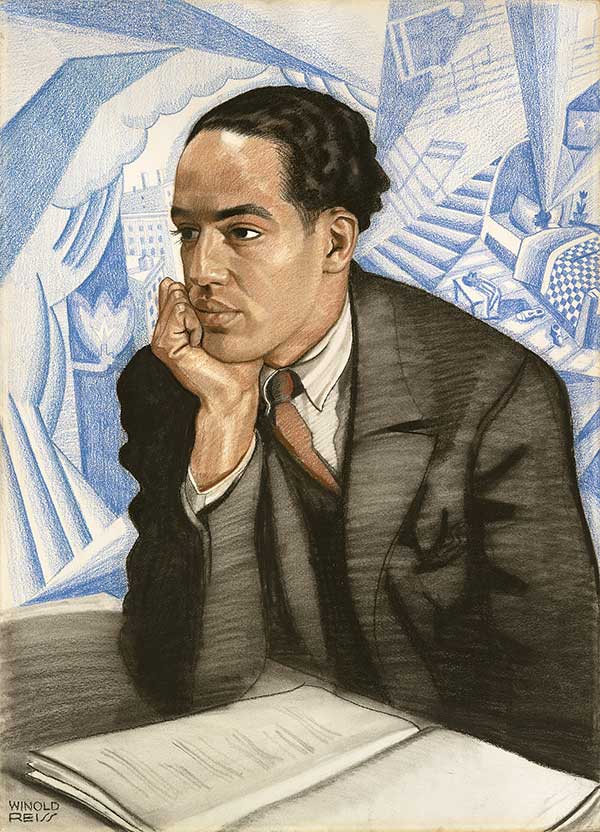Langston Hughes (1902–1967)

National Portrait Gallery, Smithsonian Institution; gift of W. Tjark Reiss, in memory of his father, Winold Reiss
About the Sitter
Born in Joplin, Missouri, in 1902, Langston Hughes said, “My earliest memories of written words were those of W.E.B. Du Bois and the Bible.” After graduating from high school, Hughes accompanied his father to Mexico. Crossing the Mississippi River by train, he wrote “The Negro Speaks of Rivers,” a poem chronicling the African American journey from ancient to modern history. He sent the poem to Crisis, the magazine Du Bois edited. He asked, “What colored person is there, do you suppose, in the United States who writes like that and is yet unknown to us?”
Leaving Columbia University after a year, Hughes visited Africa and then lived in Paris, sending work home for publication. His first volume of poetry, The Weary Blues, was published in 1926.
As the Harlem Renaissance reached full bloom in the 1920s, debate raged in local and national publications about art and literature’s role in expressing African American identities and overcoming stereotypical depictions. Hughes was hailed by some as the movement’s poet laureate. Others criticized him because of his use of realistic dialect and vivid depictions of nightclub and street scenes. Hughes actively participated in this intellectual debate but did not hesitate to realistically and sensitively portray the “low-down folks,” as he called them, in his poems, essays, short stories, plays, novels, and newspaper columns. Eventually publishing more than forty books, Hughes never lost touch with the working people.
About the Portrait
Artist Winold Reiss was born in Germany. Arriving in New York City in 1913, he soon began creating sensitive representations of African Americans and Native Americans. Reiss’s depictions avoided the racist stereotypes common at the time. This portrait, along with others created by Reiss, illustrated Alain Locke’s The New Negro: An Interpretation, a collection of Harlem literary works.
In this image, Langston Hughes appears deep in thought before an open notebook. He is well dressed, and high-rise Harlem buildings loom behind him. The portrait also includes sharp angles and harsh shapes that intrude on this thoughtful moment. Blue jazz notes swirl around Hughes, and a pair of work shoes and a simple bedroom allude to the working-class culture he explored in his work.
Learning to Look
- Identify as many objects, places, and abstract shapes as possible in the background of the portrait. What is the relationship between Hughes and the background?
- What is the main color used in the portrait? How does this color make you feel? How is it connected to Hughes?
- If you were walking down a main street in Harlem during the 1920s, what sights and sounds would you expect to encounter? What would people be doing? Compare this with the scene behind Hughes. Then compare the 1920s street scene with what you might expect to see if you walked down a main street today.
- What parts of the portrait appear still, and what parts appear to move? How did artist Winold Reiss achieve this effect, and why did he include it in the portrait?
- Read one of Hughes’s poems about writing, for example, “Theme for English B.” What anxieties and emotions fill the author’s head as he prepares to write? What inspires him? Compare the author’s attitude in the poem to his appearance in the portrait. In the portrait, what thoughts fill Hughes’s head and from where does he draw inspiration?
Activity
Publishing the Harlem Renaissance
Explain to students that Harlem Renaissance magazines, journals, and newspapers provided a forum in which to discuss African American art and literature as well as the social, political, and economic future of African Americans. Magazine contributors often disagreed, finding each other too radical or too conservative and accommodating to white society. Some magazines intentionally published works rejected by more conservative publications.
Hold a group discussion about the differences in point of view among these magazines. Divide students into small groups that will act as editorial boards of new Harlem Renaissance magazines of the 1920s. Each group should name its publication and design an appropriate cover image. Illustrations may be included throughout the magazine. Each magazine should include at least three of the following contributions:
- A “Letter from the Editor” describing the magazine’s point of view and goals
- An original literary work related to the Harlem Renaissance
- A critical review of one of Hughes’s poems
- A critical review of a Harlem Renaissance jazz song, theatrical performance, or artwork
- An editorial or opinion article contributing to the debate about the future of African Americans in the United States
- A news article related to Harlem